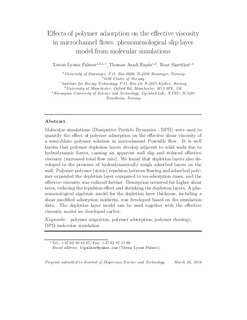Effects of polymer adsorption on the effective viscosity in microchannel flows: phenomenological slip layer model from molecular simulations
Journal article, Peer reviewed
Accepted version

Åpne
Permanent lenke
http://hdl.handle.net/11250/2593330Utgivelsesdato
2018Metadata
Vis full innførselSamlinger
Sammendrag
Molecular simulations (Dissipative Particle Dynamics - DPD) were used to quantify the effect of polymer adsorption on the effective shear viscosity of a semi-dilute polymer solution in microchannel Poseuille flow. It is well known that polymer depletion layers develop adjacent to solid walls due to hydrodynamic forces, causing an apparent wall slip and reduced effective viscosity (increased total flow rate). We found that depletion layers also developed in the presence of hydrodynamically rough adsorbed layers on the wall. Polymer-polymer (steric) repulsion between flowing and adsorbed polymer expanded the depletion layer compared to no-adsorption cases, and the effective viscosity was reduced further. Desorption occurred for higher shear rates, reducing the repulsion effect and shrinking the depletion layers. A phenomenological algebraic model for the depletion layer thickness, including a shear modified adsorption isotherm, was developed based on the simulation data. The depletion layer model can be used together with the effective viscosity model we developed earlier.